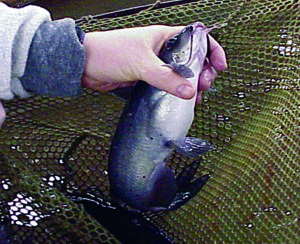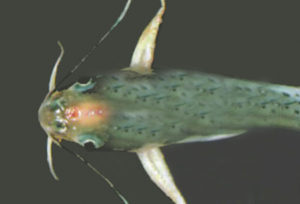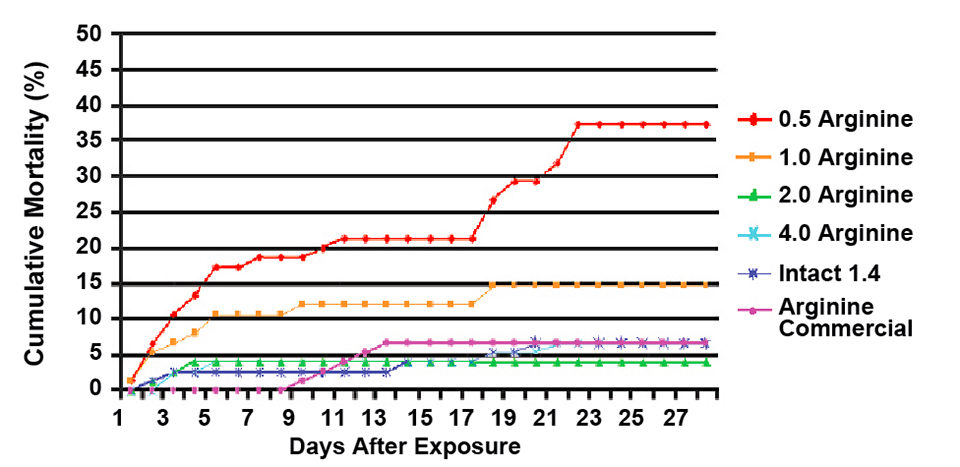Arginine a key element for regulation of kidney function in teleost fish

Metabolites of the amino acid arginine strongly affect tissue repair, cell replication and collagen synthesis – all processes involved in animal growth and survival. Dietary supplementation of such key nutrients can significantly enhance immune responses and disease resistance in various animals including fish. When diseases do take hold in aquaculture systems, arginine supplementation offers an attractive alternative to traditional pathogen treatments, which can be expensive and variably effective.
Immuno-stimulation
Supplemented arginine may be more effective as an immuno-stimulator than other nutrients such as vitamins C and E or beta-glucans because one of its metabolites – nitric oxide – not only oxidizes bacterial cell membranes but also inactivates enzymes of the mitochondrial respiratory chain, literally starving bacterial cells to death. The beneficial effects of arginine also may be noted as increased leukocyte counts, because arginine is an important substrate for biosynthesis of polyamines that are essential for cell proliferation.
Supplementation with arginine may stimulate macrophages to secrete cytokines mediated by polyamines because arginine has been shown to be a polyamine precursor. Additionally, a number of studies have shown that differences in blood cell formation and function can also be attributed to dietary protein manipulations. Arginine promotes T cell mitogenesis, enhances macrophage phagocytic functions and is indispensable for the in vitro growth and culture of animal cells.
Growth enhancer, osmoregulator
Aside from the benefits of arginine supplementation in improving immunocompetence, this amino acid is also important in promoting growth, as it plays a central role in the regulation of hormone production. Growth and thyroid hormones are nutrient-sensitive, anabolic hormones important in supporting the rapid growth of fish.
Both hormones are sensitive to amino acid intake, with arginine acting as a secretagogue that activates growth hormone biosynthesis. Both also exhibit circulating levels that directly correlate with the rate of fish growth. In addition, arginine appears to be a much more powerful insulinotropin than glucose in fish, thus targeting growth, amino acid transport and intermediary metabolism. Nutrients such as arginine may therefore promote growth in part through activation of the somatotropic or thyroid axes.
As an indispensable precursor for the neuropeptide arginine-vasotocin, arginine is a key element for regulation of kidney function in teleost fish. It has a role in water conservation through an antidiuretic action, as well as a coordinating role in physiological responses to changes in ambient salinity. Thus, arginine participates in the neurally mediated adaptation to changes in the osmotic environment of teleost fish.
Arginine research in fish

The authors’ research team at Texas A&M University pioneered the exploration of arginine metabolism in fish, an area now being investigated by other well-established laboratories in the world. Experiments in the university laboratory first indicated that cultured channel catfish macrophages synthesized nitric oxide in response to bacterial lipopolysaccharide at high rates in the presence of arginine.
The experiments with juvenile channel catfish demonstrated the existence of a compensatory mechanism that provides internally derived arginine for channel catfish fed diets with limited arginine, if glutamate is present in the diet. Consistent with these observations, a later study demonstrated that the endogenous production of citrulline in the intestine played an important role in de novo synthesis of arginine from glutamine/glutamate in juvenile channel catfish. In contrast, this same mechanism is apparently very limited or absent in juvenile red drum (Sciaenops ocellatus).
An overall assessment of the effects of arginine on the immune systems of channel catfish was accomplished through a pathogen challenge in which dietary supplementation with arginine enhanced the ability of channel catfish to survive exposure to (Edwardsiella ictaluri) (Fig. 1).
The ability of catfish phagocytes to ingest foreign particles also increases with increasing arginine supplementation in cell culture media. Hematocrit level and the counts of erythrocytes and heterophils are significantly affected (P < 0.05) by arginine levels in experimental diets. Interestingly, these effects can be achieved when dietary arginine is provided at only moderate quantities well within physiological levels and commercial standards up to four times the growth requirement.
These studies provided valuable data that indicated dietary arginine supplementation may constitute an effective means of increasing immunocompetency and disease resistance of fish, thus minimizing the need to medicate culture systems during epizootic events. Importantly, these processes do not all occur within each cell but are differentially expressed according to cell type, age and developmental stage, diet, and state of health and disease.

Limitations
Much knowledge can be derived from human, avian, swine and murine investigations on arginine. However, researchers need to carefully consider the remarkable physiological differences that the metabolism of this amino acid displays among different groups and species.
Adding to the confounding factors is the fact that, even within species, there are differences in the metabolism of arginine in various developmental stages. Therefore, while studies that compare interspecies abilities to use and metabolize arginine are fascinating, interpretation of results should be confined within the context of a particular species and specific physiological stages.
Future research
Analytical methodologies are being enhanced to quantify the bioactive compounds and metabolites derived from arginine. One novel approach utilized at Texas A&M is the integration of fish nutrition techniques with cell and tissue culture procedures to deliver an accurate assessment of arginine and glutamine metabolism in fish at different developmental stages in health and disease. This approach uses a combination of high-performance liquid chromatography procedures, sensitive radiochemical methods and sequencing of DNA that encodes for enzymes controlling the intestinal-renal axis for de novo arginine synthesis.
(Editor’s Note: This article was originally published in the March/April 2008 print edition of the Global Aquaculture Advocate.)
Now that you've finished reading the article ...
… we hope you’ll consider supporting our mission to document the evolution of the global aquaculture industry and share our vast network of contributors’ expansive knowledge every week.
By becoming a Global Seafood Alliance member, you’re ensuring that all of the pre-competitive work we do through member benefits, resources and events can continue. Individual membership costs just $50 a year. GSA individual and corporate members receive complimentary access to a series of GOAL virtual events beginning in April. Join now.
Not a GSA member? Join us.
Authors
-
Alejandro Buentello, Ph.D.
Department of Wildlife and Fisheries Sciences
Texas A&M University System
216 Heep Laboratory Building
College Station, Texas 77843-2258 USA -

Delbert M. Gatlin III, Ph.D.
Department of Wildlife and Fisheries Sciences
Texas A&M University System
216 Heep Laboratory Building
College Station, Texas 77843-2258 USA
Tagged With
Related Posts

Health & Welfare
Brazilian researchers examine amino acids in Nile tilapia diets
Determining dietary requirements for tilapia requires precise formulation. Individual amino acids must be considered to establish well-balanced diets.

Intelligence
Byproduct utilization for increased profitability, part 4
Protein hydrolysates can be produced by acid, base or enzymatic hydrolysis processes. Acid hydrolysis produces salt that makes the product unsuitable for food and destroys some essential amino acids. An optimum process for one fish or shellfish by-product may not be optimum for another.

Health & Welfare
Diets affect abalone meat quality, shell color
A preliminary study investigated the effects of diet on the meat quality and shell color of Pacific abalone. A test diet and a commercial abalone feed resulted in lower meat protein content compared to that achieved with a diet of Pacific dulse seaweed. The artificial diets also caused the abalone to have yellow or orange shells. The seaweed diet alone resulted in abalone with dark-brown shells. However, a combination of seaweed and either artificial diet improved abalone growth, meat quality and shell color.

Health & Welfare
Grain distillers dried yeast in practical diets for juvenile Pacific white shrimp
A study evaluated the production response of Pacific white shrimp fed diets containing increasing levels of grain distillers dry yeast in two growth trials.


